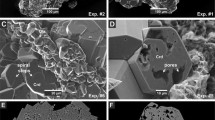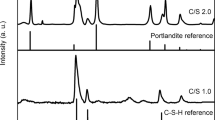Abstract
Early stage processes of Mg-rich chlorite (clinochlore) dissolution were examined, focusing especially on the structural modification at grain edges during dissolution. Focused ion beam transmission electron microscopy sample preparation was applied to crystals dissolved in a flow-through reaction system at pH 3.0 and 25°C for 31 days. The obtained Si and Mg dissolution rates are −11.49 and −11.14 (logR, mol/(m2/s)), respectively, implying dissolution is non-stoichiometric. TEM-EDX analyses of dissolved samples reveal the development of 20–50-nm thick amorphous zone at an outermost rim with a chemical gradient of Mg, lower towards the solid surface, and Si enrichment in this amorphous zone. Crystalline material is partially interwoven with amorphous one at the interface between the amorphous and crystalline regions. These results indicate that the amorphous zone was produced by selective leaching of cations except for Si. Chlorite dissolution may proceed via the formation and thickening of leached layer as a by-product of release to solution of Si at slightly slower rate than Mg.






Similar content being viewed by others
References
Aspandiar MF, Eggleton RA (2002) Weathering of chlorite: I. Reactions and products in microsystems controlled by the primary mineral. Clays Clay Miner 50:685–698. doi:10.1346/000986002762090227
Banfield JF, Murakami T (1998) Atomic-resolution transmission electron microscope evidence for the mechanism by which chlorite weathers to 1:1 semi-regular chlorite-vermiculite. Am Mineral 83:348–357
Banfield JF, Ferruzi GG, Casey WH, Westrich HR (1995) HRTEM study comparing naturally and experimentally weathered pyroxenoids. Geochim Cosmochim Acta 59:19–31. doi:10.1016/0016-7037(94)00372-S
Barnhisel RI, Bertsch PM (1989) Chlorites and hydroxyl-interlayered vermiculite and smectite. In: Dixon JB, Weed SB (eds) Minerals in soil environments. Soil Science Society of America, Madison, Wisconsin, pp 729–788
Bickmore BR, Bosbach D, Hochella MF, Charlet L, Rufe E (2001) In situ atomic force microscopy study of hectorite and nontronite dissolution: implication for phyllosilicate edge surface structures and dissolution mechanisms. Am Mineral 86:411–423
Brandt F, Bosbach D, Krawczyk-Bärsch E, Arnold T, Bernhard G (2003) Chlorite dissolution in the acid pH-range: a combined microscopic and macroscopic approach. Geochim Cosmochim Acta 67:1451–1461. doi:10.1016/S0016-7037(02)01293-0
Casey WH, Westrich HR, Banfield JF, Ferruzzi G, Arnold GW (1993) Leaching and reconstruction at the surfaces of dissolving chain-silicate minerals. Nature 366:251–256. doi:10.1038/366253a0
Gustafsson ÅB, Puigdomenech I (2003) The effect of pH on chlorite dissolution rates at 25°C. Mat Res Soc Symp Proc 757:649–655
Hamer M, Graham RC, Amrheim C, Bozhilov KN (2003) Dissolution of ripidolite (Mg, Fe-chlorite) in organic and inorganic acid solution. Soil Sci Soc Am J 67:654–661
Heaney PJ, Vicenzi EP, Giannuzzi LA, Livi KJT (2001) Focused ion beam milling: a method of site-specific sample extraction for microanalysis of earth and planetary materials. Am Mineral 86:1094–1099
Hellmann R, Penisson JM, Hervig RL, Thomassin JH, Abrioux MF (2003) An EFTEM/HRTEM high-resolution study of the near surface of labradorite feldspar altered at acid pH: evidence for interfacial dissolution–reprecipitation. Phys Chem Miner 30:192–197. doi:10.1007/s00269-003-0308-4
Hodson ME (2006) Does reactive surface area depend on grain size? Results from pH 3, 25°C far-from equilibrium flow-through dissolution experiments on anorthite and biotite. Geochim Cosmochim Acta 70:1655–1667. doi:10.1016/j.gca.2006.01.001
Kalinowski BE, Schweda P (1996) Kinetics of muscovite, phlogopite and biotite dissolution and alteration at pH 1–4, room temperature. Geochim Cosmochim Acta 60:367–385. doi:10.1016/0016-7037(95)00411-4
Kameda J, Saruwatari K, Beaufort D, Kogure T (2008) Textures and polytypes in vermiform kaolins diagenetically formed in a sandstone reservoir: a FIB-TEM investigation. Eur J Mineral 20:199–204. doi:10.1127/0935-1221/2008/0020-1806
Kilaas R (1998) Optical and near-optical filters in high-resolution electron microscopy. J Microsc 190:45–51. doi:10.1046/j.1365-2818.1998.3070861.x
Kodama H, Schnitzer M (1973) Dissolution of chlorite minerals by fulvic acid. Can J Soil Sci 53:240–243
Lee MR, Bland PA, Graham G (2003) Preparation of TEM samples by focused ion beam (FIB) techniques: applications to the study of clays and phyllosilicates in meteorites. Min Mag (Lond) 67:581–592. doi:10.1180/0026461036730119
Lee MR, Brown DJ, Smith CL, Hodson ME, Mackenzie M, Hellmann R (2007) Characterization of mineral surfaces using FIB and TEM: a case study of naturally weathered alkali feldspars. Am Mineral 92:1383–1394. doi:10.2138/am.2007.2453
Lee MR, Hodson ME, Brown DJ, Mackenzie M, Smith CL (2008) The composition and crystallinity of the near-surface regions of weathered alkali feldspars. Geochim Cosmochim Acta 72:4962–4975. doi:10.1016/j.gca.2008.08.001
Lowson RT, Comarmond MCJ, Rajaratnam G, Brown PL (2005) The kinetics of the dissolution of chlorite as a function of pH and at 25°C. Geochim Cosmochim Acta 69:1687–1699. doi:10.1016/j.gca.2004.09.028
Lowson RT, Brown PL, Comarmond MCJ, Rajaratnam G (2007) The kinetics of chlorite dissolution. Geochim Cosmochim Acta 71:1431–1447. doi:10.1016/j.gca.2006.12.008
Luce RW, Bartlett RW, Parks GA (1972) Dissolution kinetics of magnesium silicates. Geochim Cosmochim Acta 36:35–50. doi:10.1016/0016-7037(72)90119-6
Malmström M, Banwart S (1997) Biotite dissolution at 25°C: the pH dependence of dissolution rate and stoichiometry. Geochim Cosmochim Acta 61:2779–2799. doi:10.1016/S0016-7037(97)00093-8
Malmström M, Banwart S, Lewenhagen J, Duro L, Bruno J (1996) The dissolution of biotite and chlorite at 25°C in the near neutral region. J Contam Hydrol 21:201–213. doi:10.1016/0169-7722(95)00047-X
May HM, Acker JG, Smyth JR, Bricker OP, Dyar MD (1995) Aqueous dissolution of low-iron chlorite in dilute acid solutions at 25°C. In: 32nd annual meeting of Clay Minerals Society, pp 88
Nickel EH, Nichols MC (1991) Mineral reference manual. Van Nostrand Reinhold, New York
Ohnishi T, Koike H, Ishitani T, Tomimatsu S, Umemura K, Kamino T (1999) A new focused-ion beam microsampling technique for TEM observation of site-specific areas. In: Proceedings of the 25th international symposium for testing and failure analysis, pp 449–453
Paces T (1973) Steady-state kinetics and equilibrium between ground water and granitic rock. Geochim Cosmochim Acta 37:2641–2663. doi:10.1016/0016-7037(73)90270-6
Petit JC, Della Mea G, Dran JC, Magonthier MC, Mando PA, Paccagnella A (1990) Hydrated layer formation during dissolution of complex silicate glasses and minerals. Geochim Cosmochim Acta 54:1941–1955. doi:10.1016/0016-7037(90)90263-K
Rochelle CA, Bateman K, MacGregor R, Pearce JM, Savage D, Wetton PD (1996) Experimental determination of chlorite dissolution rates. Mat Res Soc Symp Proc 353:149–156
Ross GJ (1967) Kinetics of acid dissolution of an orthochlorite mineral. Can J Chem 45:3031–3034. doi:10.1139/v67-491
Rufe E, Hochella MF (1999) Quantitative assessment of reactive surface area of phlogopite during acid dissolution. Science 285:874–876. doi:10.1126/science.285.5429.874
Sasaki H, Matsuda T, Kato T, Muroga T, Iijima Y, Saitoh T, Iwase F, Yamada Y, Izumi T, Shiohara Y, Hirayama T (2004) Specimen preparation for high-resolution transmission electron microscopy using focused ion beam and Ar ion milling. J Electron Micoscopy 53:497–500. doi:10.1093/jmicro/dfh067
Sverdrup HU (1990) The kinetics of base cation release due to chemical weathering. Lund University Press, Lund
Techer I, Advocat T, Lancelot J, Liotard JM (2001) Dissolution kinetics of basaltic glasses: control by solution chemistry and protective effect on the alteration film. Chem Geol 176:235–263. doi:10.1016/S0009-2541(00)00400-9
Tisserand D, Hellmann R (2008) Bridging the ‘gap’ between laboratory dissolution and natural chemical weathering. Geochim Cosmochim Acta 72(Spec)(Suppl):A948
Turpault MP, Trotignon L (1994) The dissolution of biotite single crystals in dilute HNO3 at 24°C: evidence of an anisotropic corrosion process of mica in acidic solutions. Geochim Cosmochim Acta 58:2761–2775. doi:10.1016/0016-7037(94)90112-0
Acknowledgments
One of the authors (JK) was financially supported by JSPS Research Fellowship for Young Scientists. This work was partly supported by a Grant-in-Aid of the Ministry of Education, Culture, Sports, Science and Technology to TM. Martin Lee and one anonymous reviewer are thanked for their critical comments which helped to improve the manuscript. Most of microscopy studies were carried out at the Electron Microbeam Analysis Facility for Mineralogy at the Department of Earth and Planetary Science, the University of Tokyo.
Author information
Authors and Affiliations
Corresponding author
Rights and permissions
About this article
Cite this article
Kameda, J., Sugimori, H. & Murakami, T. Modification to the crystal structure of chlorite during early stages of its dissolution. Phys Chem Minerals 36, 537–544 (2009). https://doi.org/10.1007/s00269-009-0299-x
Received:
Accepted:
Published:
Issue Date:
DOI: https://doi.org/10.1007/s00269-009-0299-x




